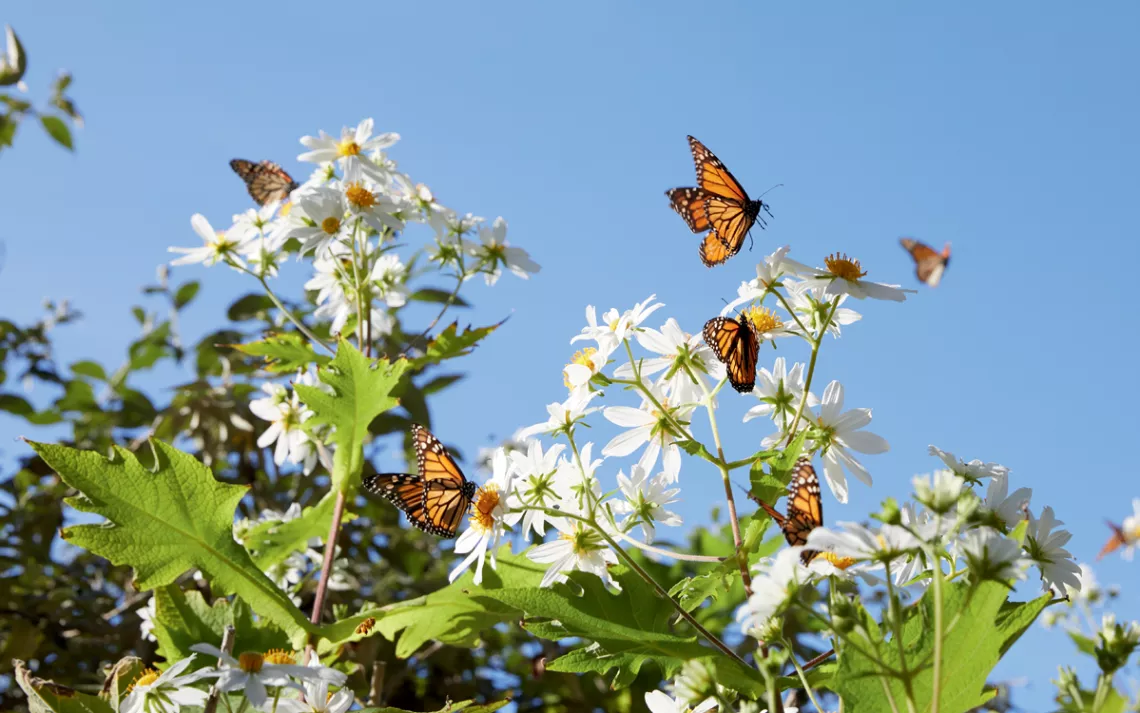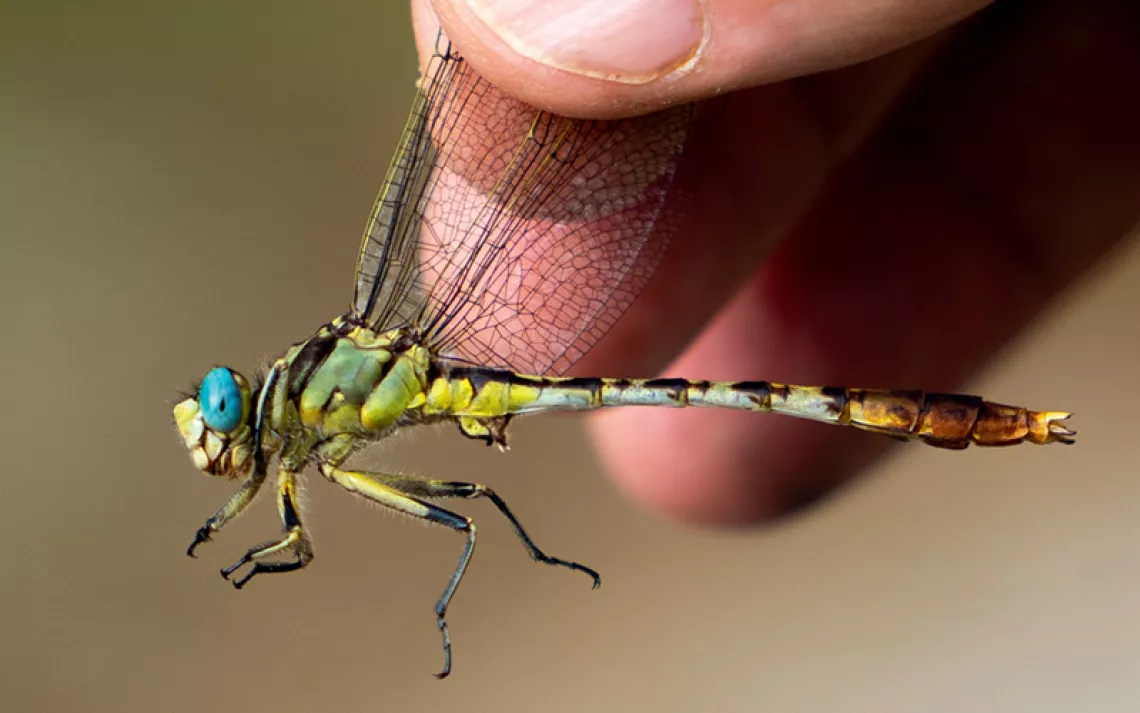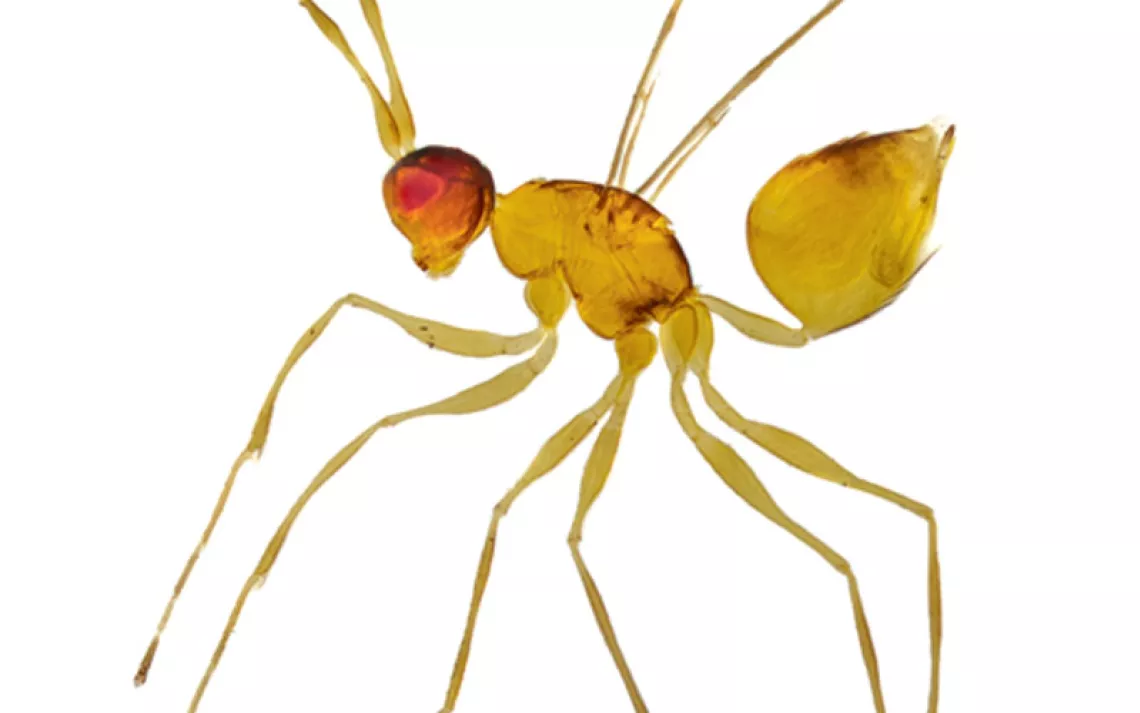Are Western Monarchs on the Rebound?
Last year's numbers were good, but no one knows if the trend will continue

Photo by Jen Siska
From a distance, the monarch butterflies could be mistaken for dead leaves. The insects cluster on tree branches with their wings folded, displaying a muted gray and orangey brown—a tessellation of drab triangles. Wildlife biologist Jessica Griffiths steps over tangled twigs and through desiccated, knee-high grass to a stand of trees and sets up a tripod and a spotting scope. Through the scope, the intricate black veins and white spots of the butterfly wings come sharply into focus. In the cool morning air, the insects are perfectly still.
We are standing in a eucalyptus grove on a small patch of undeveloped land bordered by farms near the town of Pismo Beach, on the central California coast. The air smells faintly of brussels sprouts and compost, with an overlay of something like Vicks VapoRub—the distinct scent of eucalyptus. Griffiths gazes up at the branches and smiles. There are so many butterflies.
The previous year, there were almost none. In fall 2020, fewer than 2,000 western monarch butterflies showed up at their overwintering groves along the California coast. In 1997, when counting officially began, there were more than 1.2 million. Since the 1980s, the population has dropped by an estimated 99 percent. The dismal numbers in 2020 raised fears that the monarchs were nearing extinction.
"To say it was shocking is an understatement," Griffiths says. "It was just absolutely devastating."
Then, beginning in October 2021, the butterflies returned in force. Monarch counts were over 100 times higher across the state. Tourists flocked to overwintering sites, and headlines proclaimed a comeback. At the season's peak, about 250,000 monarchs were present in California's coastal groves, according to the Xerces Society, an invertebrate group.
While the resurgence of western monarchs is certainly good news, experts warn that it doesn't necessarily indicate long-term recovery. No one knows for sure why the monarchs (the population west of the Rocky Mountains) multiplied this past season. It may have had more to do with luck than any particular conservation measure.
Most monarchs live for only a few weeks, but each year one generation of butterflies survives for more than six months, long enough to migrate and spend winter in stasis until the milkweed that caterpillars need to develop reemerges in the spring. Eastern monarchs overwinter in Mexico, while western monarchs head mostly to the California coast. Come spring, those monarchs head east, laying eggs as they go and dying soon after. Their progeny migrate as far as Idaho and New Mexico, until the end of summer sends them west again. The monarchs that arrive on the California coast in the fall are the great-grandchildren of the ones that were there the year before.
Griffiths is responsible for butterfly counts at 49 locations in San Luis Obispo County. She manages a team of about 20 volunteers who tally the insects during a three-week period between the second-to-last week of November and early December, known as the Thanksgiving Count. It's a volunteer gig that she's been doing in some form for almost two decades. In 2002, while banding songbirds as an ornithology intern near Monterey, Griffiths was "essentially conscripted" into the monarch brigade by Cal Poly scientists. She eventually went on to write a master's thesis on overwintering monarchs' tree preferences.
Today's task is to find out how many butterflies are in this little-known grove protected by the county land conservancy. It's important to count quickly, because as the sun warms them, the insects become active. Once the temperature hits 55°F, they take flight and search for nectar to keep their energy up for the long season. They're "basically solar powered," Griffiths says.
She points her binoculars at each cluster, holding her arms as still as the butterflies—she credits her shoulder strength to years of birding. Tightly packed in the dim, dappled light, the insects are almost impossible to distinguish individually. People often ask Griffiths how she manages to count them. "The joke answer I always give is that I count the legs and divide by six," she says. Really, it's more like counting jelly beans in a jar. "It's almost a volumetric estimate."
Eventually, we walk to another site nearby. Griffiths calls out numbers, and I write them on a clipboard: 50, 200, 900, 1,300. Every so often, she stops to express her amazement. In 2020, between these two sites, there were only nine butterflies. This year, Griffiths has counted 17,845.
Season-to-season population swings are common for insects, she explains. One female monarch butterfly can lay up to 300 eggs. If everything goes right, exponential growth is a guarantee.
But monarchs face myriad threats: Agriculture and development have destroyed millions of acres of milkweed and nectar plants. Pesticides take a toll. And the chaotic weather fluctuations and severe wildfires that have come with climate change disrupt the species' seasonal rhythms.
All of which make this season's resurgence all the more remarkable.
Some scientists think the monarchs simply experienced the right conditions. There were fewer fires in 2021, for one thing, says Elizabeth Crone, a population ecologist at Tufts University. Surprisingly, drought, which has persisted throughout the West, can also benefit monarchs: Drought means warmer springs and more-plentiful early milkweed.
David James, an entomologist at Washington State University, has a different, controversial theory for why monarchs seem to have rebounded. A growing population now live and breed year-round in California's warming cities, and James believes that these butterflies reverted to their migratory ways in response to a cooler fall, helping to bolster 2021 overwintering numbers.
Other factors could be contributing to the rebound: Maybe some of the larger eastern monarch population came to California instead of Mexico. Or maybe there were more butterflies in 2020 than recorded because they were clustering in overwintering sites not yet identified.
Although they may not agree on the exact reasons, scientists who study the butterflies have long known that such a recovery was possible. This knowledge is what gave Griffiths hope even in the darkest moments. She has been saying for years that the butterflies could make a comeback.
As she admires the clusters in front of her, two men walk past. "Lots of monarchs?" one asks. "Tons!" Griffiths replies, giddy with excitement. She knew this could happen, she repeats. She just didn't think it would.
This article appeared in the Spring 2022 quarterly edition with the headline "Welcome Back."
 The Magazine of The Sierra Club
The Magazine of The Sierra Club



